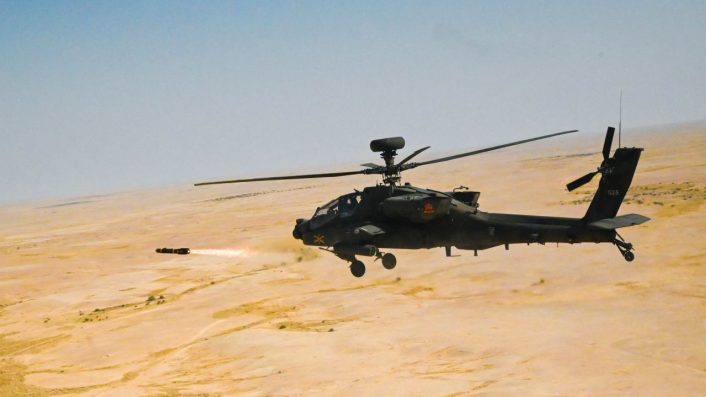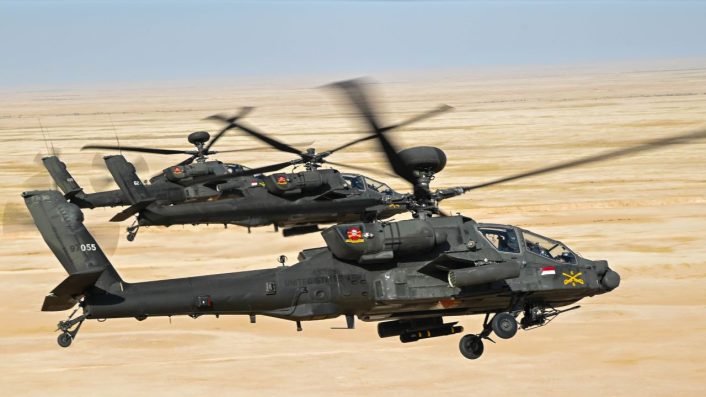The Red Sands Counter-UAS drills took place in a region with heavy UAS activity and with an Ally that combated asymmetric drone attacks by the Houthis much before the wars in Ukraine or Gaza.
This year’s iteration of the Red Sands exercise between the U.S. and KSA (Kingdom of Saudi Arabia), in the CENTCOM (Central Command) area of responsibility, saw the participation of robot dogs, AH-64 Apache helicopters firing Hellfire missiles to shoot down drones, UGV (Unmanned Ground Vehicles) and a quadcopter for tactical resupply.
The exercise, which focuses on counter-UAS (Unmanned Aerial Systems) defense, was held earlier this month and also saw the participation of the U.S. Army’s DEVCOM-AC (Development Command-Armaments Center), which arranged the presence of some new advanced systems.
Taking place at the Red Sands Integrated Experimentation Center in Saudi Arabia, the exercise is held twice each year. While some photos were released on the DVIDS network, no press statements or details were divulged. Last year, officials said Red Sands 23-2 was focused on strengthening military relations between the two countries, experimenting with cutting-edge technologies, and developing procedures to defeat UAS threats while increasing the combat readiness against emerging UAS threats.
Metalhead – Interesting stuff at CENTCOM/Saudi Red Sands Counter-s UAS 2024 Exercise
1⃣Weaponized Quadrupedal-Unmanned Ground Vehicle (Q-UGV)
2⃣Tactical Resupply Vehicle (TRV 150)
3⃣Rheinmetall Mission Master XT Autonomous Unmanned Ground Vehicle (A-UGV) w/dual M134D miniguns pic.twitter.com/hIwvf2fna6— 🇺🇸𝗢𝗹𝗱 𝗦𝘂𝗯𝗺𝗮𝗿𝗶𝗻𝗲𝗿⚓️ (@USN_Submariner) September 27, 2024
Some of the systems deployed for Red Sands 24-2 have not yet figured in any US-led bilateral military exercise with an ally, especially outside the continental United States. The robot dog, for instance, has been extensively tested by both the U.S Air Force, U.S. Army and the U.S. Marine Corps but within the United States. U.S. Army AH-64 Apache helicopters fired an AGM-114 Hellfire missile at a small drone, which is also a rare maneuver not previously disclosed.
The drill took place in a region with heavy UAS activity and with an Ally that combated asymmetric drone attacks by the Houthis much before the war in Ukraine or in Gaza. This was particularly true until 2019, at the height of the war in Yemen, the Iran-Saudi Arabia tensions and proxy war.
Nevertheless, the exercise still marks the importance of both soft/hard kill, kinetic/non-kinetic and DEW (Directed Energy Weapon)-based counter-drone systems, for use against swarms of cheap yet effective UAVs, that have threatened larger and powerful targets from air defense missiles to warships alike. The conflict in the Red Sea, with the Houthis’ simple UAVs, ballistic missiles and cruise missiles attacks against U.S. Navy vessels, stresses the importance of equally simple drone detection and countering systems, with a focus also on avoiding the use of costly multi-million dollar missiles.
Robot Dog
The system that stood out from the platforms that were included in the exercise was the Quadrupedal-Unmanned Ground Vehicle (Q-UGV) that was described as “going over rehearsals” at the Red Sands IEC on Sep. 18, 2024. Details of the drills and the activities are not available, but the Ghost Robotics Vision 60 (not mentioned in the DVIDS caption), has emerged in previous U.S. Army, USMC and USAF drills.
Given the context of the Red Sands drills and previous exercises with the Vision 60, it could be assumed that it is being envisioned to shoot down aerial drones. Here the Vision 60 is shown with a training variant, as denoted by the yellow muzzle device, of the fully automatic M4A1 rifle also used by the USAF Security Forces.
On Sep. 1, 2020, the same Ghost Robotics Vision 60 prototype appeared in an Advanced Battle Management System (ABMS) Onramp 2 exercise at Nevada’s Nellis AFB, where it participated in a base security drill. A U.S. Air Force Tech. Sgt. was seen operating the ‘robot dog’, described in the caption as a “prototype,” securing the base’s perimeter.
On Mar. 18, 2024, during the U.S. Army’s Project Convergence – Capstone 4 at Fort Irwin, California, a “Quadruped Ghost robotic dog” was seen “deployed as part of an urban assault during a series of Human Machine Integration experiments in a training environment.” It described quadrupeds as “midsized, high endurance, agile unmanned ground vehicles that provide enhanced situational awareness and support for frontline Soldiers, acting as their eyes and ears.”
The Vision 60 then appeared in the U.S. Army’s Operation Hard Kill at Fort Drum, New York, early in August 2024, in the same configuration as in Red Sands, with the AR-15-type assault rifle on a turret and the large electro-optical (EO) system.
⚡️During exercises, the 🇺🇸US Army tested a “robot dog” with artificial intelligence armed with an AR-15 rifle to destroy drones. https://t.co/XQC7XGOMgs pic.twitter.com/E1EPFPF5k0
— 🪖MilitaryNewsUA🇺🇦 (@front_ukrainian) August 10, 2024
The War Zone concluded that the night, thermal mode EO system and the swiveling turret are meant to fight targets in the sky, implying the U.S. Army is exploring the ground robot to shoot down aerial drones. The degree of autonomy or man-in-the-loop element is not known. DEVCOM also had a role during Hard Kill, along with the Army’s 10th Mountain Division. Thus the same capability is now being explored in a ‘hot zone’ like the Middle East with a persisting hostile drone problem.
Gen. Michael “Erik” Kurilla, USCENTCOM CDR, and Gen. Fayyad al-Ruwali, Kingdom of Saudi Arabia Chief of the General Staff observed Red Sands 23-2 & the progress the two nations have made in defeating threat unmanned aerial systems
MEDIA (https://t.co/89ZbpPlnvt)@modgovksa pic.twitter.com/IDaG8kE8QK
— U.S. Central Command (@CENTCOM) September 14, 2023
Late in 2023, the Marine Corps also tested a Chinese-made Unitree Go1 quadrupedal system that demonstrated various mobility, maneuvering and load-carrying capabilities, eventually firing the M72 LAW (Light Anti-Tank Weapon) from its back. Of course, this does not suggest the US is set to mass acquire the Chinese system for induction but rather determine its combat utility.
In other words, if the US decides to officially acquire such a system, it would be a US-made robot or at least one developed by an Ally.

Other systems
The photos from Red Sands also showed Rheinmetall’s Mission Master XT, whose presence there was arranged by “industry partners with DEVCOM.” The UGV is equipped with large wheels, which take up most of the chassis, and has dual M134D 7.62 mm miniguns cued to what seems to be a small radar antenna to detect drones.
The photos also showed the Oshkosh M-ATV (MRAP-All Terrain Vehicle) equipped with the Crows Blade counter-UAS system. The turret, which the U.S. Army has been testing since late-2019, has an integrated radar and a .50 Caliber heavy machine gun. The Ballistic Low Altitude Drone Engagement System (BLADE) is cued to a Common Remotely Operated Weapon Station (CROWS).
Lastly, a photo showed a U.S. Army’s AH-64 Apache attack helicopter firing a AGM-114 Hellfire at a “small-UAS” on Sep. 23. Details on the scenario or the type of drone that was brought down are not known, but this could possibly be the first time the air-to-ground missile is being used for this type of engagement by the U.S. Army. Similar engagements have often been performed by Israeli Apaches against Iranian-made drones. Another picture showed three Apaches flying in a “holding pattern” at the Red Sands IEC before the live fire.


